第 15 章IO流
第 15 章IO流
15.1 文件
15.1.1 什么是文件
文件:对我们并不陌生,文件是保存数据的地方,比如大家经常使用的word文档,txt文件,excel文件...都是文件。它既可以保存一张图片,也可以保持视频,声音...
15.1.2 文件流
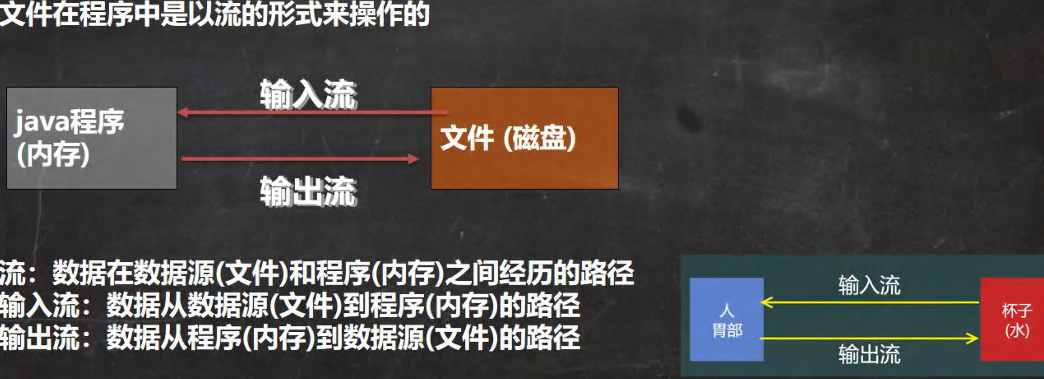
15.2 常用的文件操作
15.2.1 创建文件对象相关构造器和方法
package com.ming.file;
import org.junit.jupiter.api.Test;
import java.io.File;
import java.io.IOException;
/**
* @author 明
* @version 1.0
*/
public class FileCreate {
public static void main(String[] args) {
}
//方式1 new File(String pathname)
@Test
public void create01(){
String filePath = "D:/JAVA/韩顺平/代码/chapter19/1.txt";
File file = new File(filePath);
try {
file.createNewFile();
System.out.println("文件创建成功");
} catch (IOException e) {
e.printStackTrace();
}
}
//方式2 new File(File parent,String child) //根据父目录文件+子路径构建
//D:/JAVA/韩顺平/代码/chapter19/2.txt
@Test
public void create02(){
File parent = new File("D:/JAVA/韩顺平/代码/chapter19/");
String fileName = "2.txt";
//这里的file对象,在java程序中,只是一个对象
//只有执行了createNewFile 方法,才会真正的,在磁盘创建该文件
File file = new File(parent, fileName);
try {
file.createNewFile();
System.out.println("文件创建成功");
} catch (IOException e) {
e.printStackTrace();
}
}
@Test
//方式3 new File(String parent,String child) //根据父目录+子路径构建
public void create03(){
String parent = "D:/JAVA/韩顺平/代码/chapter19/";
String fileName = "3.txt";
File file = new File(parent,fileName);
try {
file.createNewFile();
System.out.println("文件创建成功");
} catch (IOException e) {
e.printStackTrace();
}
}
}
15.2.2 获取文件的相关信息
getName、getAbsolutePath、getParent、length、exists、isFile、isDirectory

15.2.3 应用案例演示 FileInformation.java
如何获取到文件的大小,文件名,路径,父File,是文件还是目录(目录本质也是文件,一种特殊的文件),是否存在。
package com.ming.file;
import org.junit.jupiter.api.Test;
import java.io.File;
/**
* @author 明
* @version 1.0
*/
public class FileInformation {
public static void main(String[] args) {
}
//获取文件的信息
@Test
public void info() {
//先创建文件对象
File file = new File("D:/JAVA/韩顺平/代码/chapter19/1.txt");
//调用相应的方法,得到对应信息
System.out.println("文件名字=" + file.getName());
//getName、getAbsolutePath、getParent、length、exists、isFile、isDirectory
System.out.println("文件绝对路径=" + file.getAbsolutePath());
System.out.println("文件父级目录=" + file.getParent());
System.out.println("文件大小(字节)=" + file.length());
System.out.println("文件是否存在=" + file.exists());//T
System.out.println("是不是一个文件=" + file.isFile());//T
System.out.println("是不是一个目录=" + file.isDirectory());//F
}
}
15.2.4 目录的操作和文件删除
public class Directory_ {
public static void main(String[] args) {
}
@Test
public void test01() {
String filePath = "D:/JAVA/韩顺平/代码/chapter19/3.txt";
File file = new File(filePath);
if(file.exists()){
if(file.delete()){
System.out.println(filePath + "删除成功");
} else {
System.out.println(filePath + "删除失败");
}
} else {
System.out.println("该文件不存在...");
}
}
//判断 D:\\demo02 是否存在,存在就删除,否则提示不存在
//这里我们需要体会到,在java编程中,目录也被当做文件
@Test
public void m2() {
String filePath = "D:\\demo02";
File file = new File(filePath);
if (file.exists()) {
if (file.delete()) {
System.out.println(filePath + "删除成功");
} else {
System.out.println(filePath + "删除失败");
}
} else {
System.out.println("该目录不存在...");
}
}
//判断 D:\\demo\\a\\b\\c 目录是否存在,如果存在就提示已经存在,否则就创建
@Test
public void m3() {
String directoryPath = "D:\\demo\\a\\b\\c";
File file = new File(directoryPath);
if (file.exists()) {
System.out.println(directoryPath + "存在..");
} else {
if (file.mkdirs()) { //创建一级目录使用mkdir() ,创建多级目录使用mkdirs()
System.out.println(directoryPath + "创建成功..");
} else {
System.out.println(directoryPath + "创建失败...");
}
}
}
}
15.3 IO 流原理及流的分类
15.3.1 Java IO 流原理
- I/O是Input/Output的缩写,I/O技术是非常实用的技术,用于处理数据传输。如读/写文件,网络通讯等。
- Java程序中,对于数据的输入/输出操作以“流(stream)”的方式进行。
- java.io包下提供了各种“流”类和接口,用以获取不同种类的数据,并通过方法输入或输出数据
- 输入input:读取外部数据(磁盘、光盘等存储设备的数据)到程序(内存)中。
- 输出output:将程序(内存)数据输出到磁盘、光盘等存储设备中
15.3.2 流的分类
- 按操作数据单位不同分为:字节流(8 bit) 二进制文件,字符流(按字符) 文本文件
- 按数据流的流向不同分为:输入流,输出流
- 按流的角色的不同分为:节点流,处理流/包装流
| (抽象基类) | 字节流 | 字符流 |
|---|---|---|
| 输入流 | InputStream | Reader |
| 输出流 | OutputStream | Writer |
- Java的IO流共涉及40多个类,实际上非常规则,都是从如上4个抽象基类派生的。
- 由这四个类派生出来的子类名称都是以其父类名作为子类名后缀。
15.4 IO 流体系图-常用的类
1. IO 流体系图
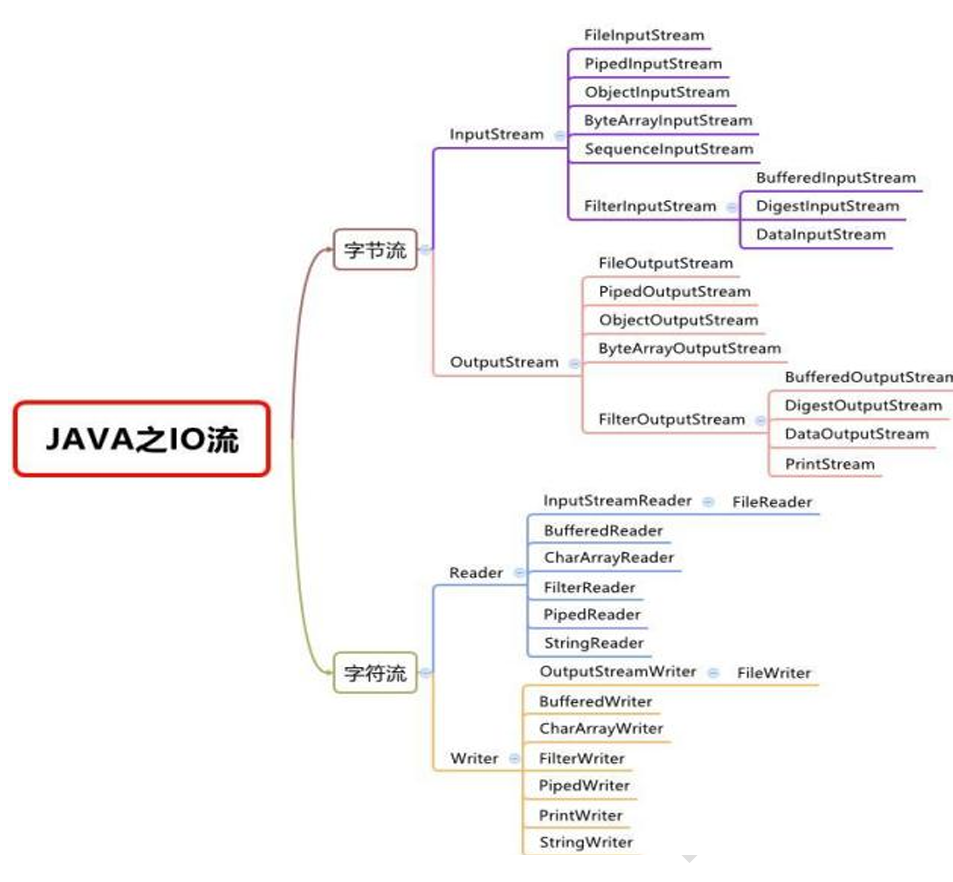
2. 文件 VS 流
(

15.4.1 FileInputStream 介绍
15.4.2 FileInputStream 应用实例 FileInputStream_.java
package com.ming.inputstream_;
import org.junit.jupiter.api.Test;
import java.io.FileInputStream;
import java.io.FileNotFoundException;
import java.io.IOException;
/**
* @author 明
* @version 1.0
*/
public class FileInputStream_ {
public static void main(String[] args) {
}
/**
* 演示读取文件...
* 单个字节的读取,效率比较低
* -> 使用 read(byte[] b)
*/
@Test
public void readFile01() {
String filePath = "D:\\JAVA\\韩顺平\\代码\\chapter19\\1.txt";
int readData = 0;
FileInputStream fileInputStream = null;
try {
//创建 FileInputStream 对象,用于读取 文件
fileInputStream = new FileInputStream(filePath);
//从该输入流读取一个字节的数据。 如果没有输入可用,此方法将阻止。
//如果返回-1 , 表示读取完毕
while ((readData = fileInputStream.read()) != -1) {
System.out.print((char)readData);//转成char显示
}
} catch (IOException e) {
e.printStackTrace();
} finally {
//关闭文件流,释放资源.
try {
fileInputStream.close();
} catch (IOException e) {
e.printStackTrace();
}
}
}
/**
* 使用 read(byte[] b) 读取文件,提高效率
*/
@Test
public void readFile02() {
String filePath = "D:\\JAVA\\韩顺平\\代码\\chapter19\\1.txt";
//字节数组
byte[] buf = new byte[8]; //一次读取8个字节.
int readLen = 0;
FileInputStream fileInputStream = null;
try {
//创建 FileInputStream 对象,用于读取 文件
fileInputStream = new FileInputStream(filePath);
//从该输入流读取最多b.length字节的数据到字节数组。 此方法将阻塞,直到某些输入可用。
//如果返回-1 , 表示读取完毕
//如果读取正常, 返回实际读取的字节数
while ((readLen = fileInputStream.read(buf)) != -1) {
System.out.print(new String(buf, 0, readLen));//显示
}
} catch (IOException e) {
e.printStackTrace();
} finally {
//关闭文件流,释放资源.
try {
fileInputStream.close();
} catch (IOException e) {
e.printStackTrace();
}
}
}
}
15.4.3 FileOutputStream 介绍
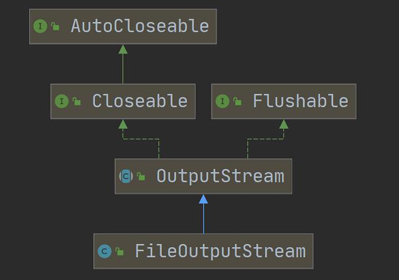
15.4.4 FileOutputStream 应用实例 1 FileOutputStream01.java
package com.ming.outputstream_;
import org.junit.jupiter.api.Test;
import java.io.FileNotFoundException;
import java.io.FileOutputStream;
import java.io.IOException;
/**
* @author 明
* @version 1.0
*/
public class FileOutputStream_ {
public static void main(String[] args) {
}
@Test
public void f(){
String filePath = "D:\\JAVA\\韩顺平\\代码\\chapter19\\3.txt";
FileOutputStream fileOutputStream = null;
try {
//得到 FileOutputStream对象 对象
//老师说明
//1. new FileOutputStream(filePath) 创建方式,当写入内容是,会覆盖原来的内容
//2. new FileOutputStream(filePath, true) 创建方式,当写入内容是,是追加到文件后面
fileOutputStream = new FileOutputStream(filePath);
//写入一个字节
//fileOutputStream.write('H');//
//写入字符串
String str = "ming,world!";
//str.getBytes() 可以把 字符串-> 字节数组
//fileOutputStream.write(str.getBytes());
/*
write(byte[] b, int off, int len) 将 len字节从位于偏移量 off的指定字节数组写入此文件输出流
*/
fileOutputStream.write(str.getBytes(), 0, 3);
} catch (IOException e) {
e.printStackTrace();
} finally {
try {
fileOutputStream.close();
} catch (IOException e) {
e.printStackTrace();
}
}
}
}
15.4.5 FileOutputStream应用实例2 FileCopy.java
package com.ming.outputstream_;
import java.io.FileInputStream;
import java.io.FileNotFoundException;
import java.io.FileOutputStream;
import java.io.IOException;
/**
* @author 明
* @version 1.0
*/
public class FileCopy {
//思路分析
//1. 创建文件的输入流 , 将文件读入到程序
//2. 创建文件的输出流, 将读取到的文件数据,写入到指定的文件.
public static void main(String[] args) {
String infilePath = "C:/Users/yemin/Pictures/5.png";
String outfilePath = "C:/Users/yemin/Pictures/555.png";
FileInputStream fis = null;
FileOutputStream fos = null;
try {
fis = new FileInputStream(infilePath);
fos = new FileOutputStream(outfilePath);
// int len = 0;
// while((len = fis.read()) != -1){
// fos.write(len);
// }
//读取到后,就写入到文件 通过 fileOutputStream
//即,是一边读,一边写
byte[] buffer = new byte[1024];
int readlen = 0;
while((readlen = fis.read(buffer)) != -1){
fos.write(buffer,0,readlen);
}
} catch (IOException e) {
e.printStackTrace();
} finally {
try {
fis.close();
fos.close();
} catch (IOException e) {
e.printStackTrace();
}
}
}
}
15.4.6 FileReader 和 FileWriter 介绍

15.4.7 FileReader 相关方法:
new FileReader(File/String)read:每次读取单个字符,返回该字符,如果到文件末尾返回-1read(char[]): 批量读取多个字符到数组,返回读取到的字符数,如果到文件末尾返回-1
相关API:
new String(char[]):将char[]转换成Stringnew String(char[],off,len):将char[]的指定部分转换成String
15.4.8 FileWriter 常用方法
new FileWriter(File/String): 覆盖模式,相当于流的指针在首端new FileWriter(File/String,true): 追加模式,相当于流的指针在尾端write(int):写入单个字符write(char[]):写入指定数组write(char[],off,len):写入指定数组的指定部分write (string): 写入整个字符串write(string,off,len):写入字符串的指定部分
相关API:String类:toCharArray:将String转换成char[]
注意:
FileWriter使用后,必须要关闭(close)或刷新(flush),否则写入不到指定的文件!
15.4.9 FileReader 和 FileWriter 应用案例 FileReader_.java
要求:
- 使用
FileReader从story.txt读取内容,并显示
package com.ming.reader_;
import org.junit.jupiter.api.Test;
import java.io.FileNotFoundException;
import java.io.FileReader;
import java.io.IOException;
/**
* @author 明
* @version 1.0
*/
public class FileReader_ {
public static void main(String[] args) {
}
/**
* 单个字符读取文件
*/
@Test
public void readFile01() throws IOException {
String filePath = "D:\\JAVA\\韩顺平\\代码\\chapter19\\1.txt";
FileReader fileReader = null;
int data = 0;
//1. 创建FileReader对象
try {
fileReader = new FileReader(filePath);
while((data = fileReader.read()) != -1){
System.out.print((char)data);
}
} catch (IOException e) {
e.printStackTrace();
}finally {
fileReader.close();
}
}
/**
* 字符数组读取文件
*/
@Test
public void readFile02() throws IOException {
String filePath = "D:\\JAVA\\韩顺平\\代码\\chapter19\\1.txt";
FileReader fileReader = null;
int readlen = 0;
char[] chars = new char[1024];
//1. 创建FileReader对象
try {
fileReader = new FileReader(filePath);
while((readlen = fileReader.read(chars)) != -1){
System.out.print(new String(chars,0,readlen));
}
} catch (IOException e) {
e.printStackTrace();
}finally {
fileReader.close();
}
}
}
15.5 节点流和处理流
15.5.1 基本介绍

15.5.2 节点流和处理流一览图
| 分 类 | 字节输入流 | 字节输出流 | 字符输入流 | 字符输出流 |
|---|---|---|---|---|
| 抽象基类 | InputStream |
OutputStream |
Reader |
Writer |
| 访问文件 | FileInputStream |
FileOutputStream |
FileReader |
FileWriter |
| 访问数组 | ByteArrayInputStream |
ByteArrayOutputStream |
CharArrayReader |
CharArrayWriter |
| 访问管道 | PipedInputStream |
PipedOutputStream |
PipedReader |
PipedWriter |
| 访问字符串 | StringReader |
StringWriter |
||
| 缓冲流 | BufferedInputStream |
BufferedOutputStream |
BufferedReader |
BufferedWriter |
| 转换流 | InputStreamReader |
OutputStreamWriter |
||
| 对象流 | ObjectInputStream |
ObjectOutputStream |
||
| 抽象基类 | FilterInputStream |
FilterOutputStream |
FilterReader |
FilterWriter |
| 打印流 | PrintStream |
PrintWriter |
||
| 推回输入流 | PushbackInputStream |
PushbackReader |
||
| 特殊流 | DataInputStream |
DataOutputStream |
15.5.3 节点流和处理流的区别和联系
- 节点流是底层流/低级流,直接跟数据源相接。
- 处理流(包装流)包装节点流,既可以消除不同节点流的实现差异,也可以提供更方便的方法来完成输入、输出。[源码理解]
- 处理流(也叫包装流)对节点流进行包装,使用了修饰器设计模式,不会直接与数据源相连[模拟修饰器设计模式=> 小伙伴就会非常清楚.]
15.5.4 处理流的功能主要体现在以下两个方面:
- 性能的提高: 主要以增加缓冲的方式来提高输入输出的效率。
- 操作的便捷: 处理流可能提供了一系列便捷的方法来一次输入输出大批量的数据, 使用更加灵活方便
15.5.5 处理流-BufferedReader 和 BufferedWriter
BufferedReader和BufferedWriter属于字符流,是按照字符来读取数据的- 关闭时处理流,只需要关闭外层流即可[后面看源码]
应用案例
- 使用
BufferedReader读取文本文件,并显示在控制台BufferedReader_.java
package com.ming.reader_;
import java.io.BufferedReader;
import java.io.FileNotFoundException;
import java.io.FileReader;
/**
* @author 明
* @version 1.0
*/
public class BuffererReader_ {
public static void main(String[] args) throws Exception {
String filePath = "D:\\JAVA\\韩顺平\\代码\\chapter19\\2.txt";
//创建bufferedReader
BufferedReader bufferedReader = new BufferedReader(new FileReader(filePath));
//读取
String line;//按行读取效率高
//说明
//1. bufferedReader.readLine() 是按行读取文件
//2. 当返回null 时,表示文件读取完毕
while((line = bufferedReader.readLine()) != null){
System.out.println(line);
}
//关闭流, 这里注意,只需要关闭 BufferedReader ,因为底层会自动的去关闭 节点流
//FileReader。
/*
public void close() throws IOException {
synchronized (lock) {
if (in == null)
return;
try {
in.close();//in 就是我们传入的 new FileReader(filePath), 关闭了.
} finally {
in = null;
cb = null;
}
}
}
*/
bufferedReader.close();
}
}
15.5.6 处理流-BufferedInputStream 和 BufferedOutputStream
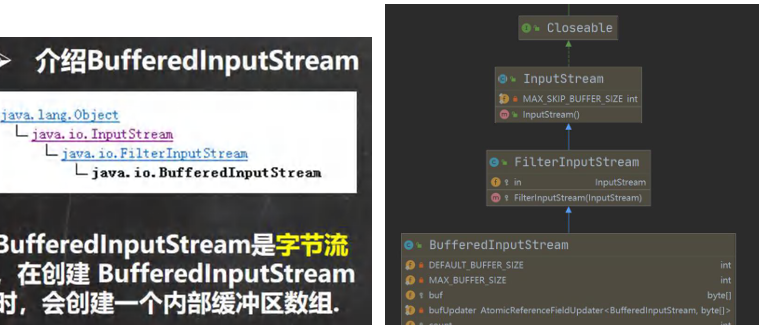
15.5.7 介绍BufferedOutputStream
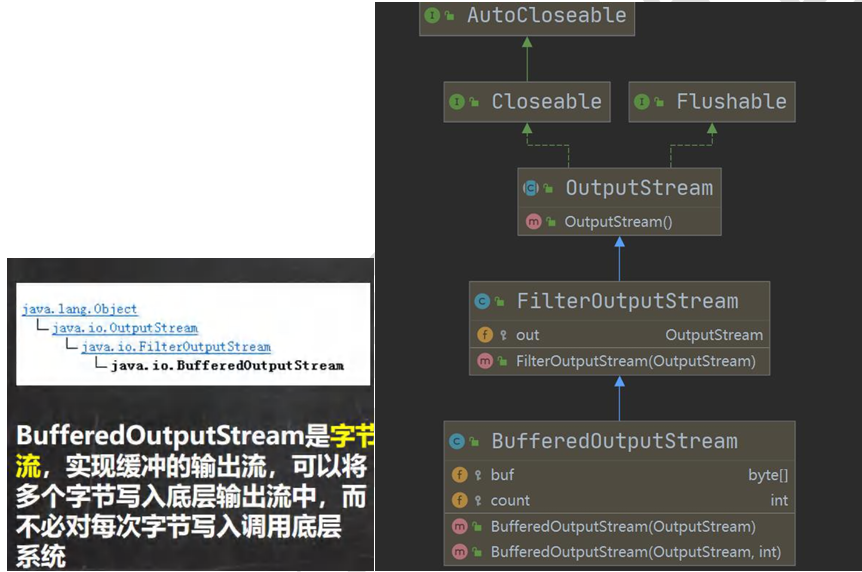
package com.ming.outputstream_;
import java.io.*;
/**
* @author 明
* @version 1.0
*/
public class BufferedCopy02 {
public static void main(String[] args) throws IOException {
String srcFilePath = "C:/Users/yemin/Pictures/1.jpg";
String destFilePath = "C:/Users/yemin/Pictures/111.jpg";
BufferedInputStream bis = null;
BufferedOutputStream bos = null;
bis = new BufferedInputStream(new FileInputStream(srcFilePath));
bos = new BufferedOutputStream(new FileOutputStream(destFilePath));
byte[] buffer = new byte[1024];
int len = 0;
while((len = bis.read(buffer)) != -1){
bos.write(buffer,0,len);
}
bis.close();
bos.close();
System.out.println("拷贝完毕");
}
}
15.5.8 对象流-ObjectInputStream 和 ObjectOutputStream
看一个需求
- 将
int num = 100这个int数据保存到文件中,注意不是 100 数字,而是int 100,并且,能够从文件中直接恢复int 100 - 将
Dog dog = new Dog(“小黄”, 3)这个dog对象保存到文件中,并且能够从文件恢复。 - 上面的要求,就是能够将 基本数据类型 或者 对象 进行 序列化和反序列化操作
序列化和反序列化
- 序列化就是在保存数据时,保存数据的值和数据类型
- 反序列化就是在恢复数据时,恢复数据的值和数据类型
- 需要让某个对象支持序列化机制,则必须让其类是可序列化的,为了让某个类是可序列化的,该类必须实现如下两个接口之一:
Serializable:这是一个标记接口,没有方法Externalizable:该接口有方法需要实现,因此我们一般实现上面的Serializable接口

15.5.9 对象流介绍
功能:提供了对基本类型或对象类型的序列化和反序列化的方法
ObjectOutputStream 提供 序列化功能
ObjectInputStream 提供 反序列化功能

应用案例
-
使用
ObjectOutputStream序列化 基本数据类型和一个Dog对象(name,age), 并保存到data.dat文件中ObjectOutStream_.javapackage com.ming.outputstream_; import java.io.FileOutputStream; import java.io.ObjectOutputStream; /** * @author 明 * @version 1.0 */ public class ObjectOutStream_ { public static void main(String[] args) throws Exception{ //序列化后,保存的文件格式,不是存文本,而是按照他的格式来保存 String filePath = "D:\\JAVA\\韩顺平\\代码\\chapter19\\5.dat"; ObjectOutputStream oos = new ObjectOutputStream(new FileOutputStream(filePath)); oos.writeInt(100); oos.writeBoolean(true); oos.writeChar('a'); oos.writeDouble(9.5); oos.writeUTF("解放的快"); //保存一个dog对象 oos.writeObject(new Dog("旺财", 10, "日本", "白色")); oos.close(); System.out.println("数据保存完毕(序列化形式)"); } } class Dog implements Serializable { private String name; private int age; //序列化对象时,默认将里面所有属性都进行序列化,但除了static或transient修饰的成员 private static String nation; private transient String color; //序列化对象时,要求里面属性的类型也需要实现序列化接口 private Master master = new Master(); //serialVersionUID 序列化的版本号,可以提高兼容性 private static final long serialVersionUID = 1L; public Dog(String name, int age, String nation, String color) { this.name = name; this.age = age; this.color = color; this.nation = nation; } @Override public String toString() { return "Dog{" + "name='" + name + '\'' + ", age=" + age + ", color='" + color + '\'' + '}' + nation + " " +master; } public String getName() { return name; } public void setName(String name) { this.name = name; } public int getAge() { return age; } public void setAge(int age) { this.age = age; } } class Master implements Serializable { } -
使用
ObjectInputStream读取data.dat并反序列化恢复数据
package com.ming.inputstream_;
import com.ming.outputstream_.Dog;
import java.io.FileInputStream;
import java.io.IOException;
import java.io.ObjectInputStream;
/**
* @author 明
* @version 1.0
*/
public class ObjectInputStream_ {
public static void main(String[] args) throws Exception {
//指定反序列化的文件
String filePath = "D:\\JAVA\\韩顺平\\代码\\chapter19\\5.dat";
ObjectInputStream ois = new ObjectInputStream(new FileInputStream(filePath));
//读取
//1. 读取(反序列化)的顺序顺序和你保存数据(序列化)的顺序一致
//2. 否则会出现异常
System.out.println(ois.readInt());
System.out.println(ois.readBoolean());
System.out.println(ois.readChar());
System.out.println(ois.readDouble());
System.out.println(ois.readUTF());
//dog 的编译类型是 Object , dog 的运行类型是 Dog
Object dog = ois.readObject();
System.out.println("运行类型=" + dog.getClass());
System.out.println("dog信息=" + dog);//底层 Object -> Dog
//这里是特别重要的细节:
//1. 如果我们希望调用Dog的方法, 需要向下转型
//2. 需要我们将Dog类的定义,放在到可以引用的位置
Dog dog2 = (Dog)dog;
System.out.println(dog2.getName()); //旺财..
//关闭流, 关闭外层流即可,底层会关闭 FileInputStream 流
ois.close();
}
}
15.6打印流-PrintStream和PrintWriter
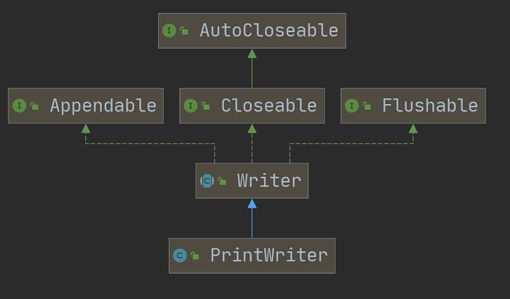
package com.ming.printstream_;
import java.io.IOException;
import java.io.PrintStream;
/**
* @author ming
* @version 1.0
* 演示PrintStream (字节打印流/输出流)
*/
public class PrintStream_ {
public static void main(String[] args) throws IOException {
PrintStream out = System.out;
//在默认情况下,PrintStream 输出数据的位置是 标准输出,即显示器
/*
public void print(String s) {
if (s == null) {
s = "null";
}
write(s);
}
*/
out.println("我发到付的");
out.write("666".getBytes());
//因为print底层使用的是write , 所以我们可以直接调用write进行打印/输出
out.close();
//我们可以去修改打印流输出的位置/设备
//1. 输出修改成到 "D:\JAVA\韩顺平\代码\chapter19\1.txt"
//2. "hello, ming~" 就会输出到 D:\JAVA\韩顺平\代码\chapter19\1.txt
//3. public static void setOut(PrintStream out) {
// checkIO();
// setOut0(out); // native 方法,修改了out
// }
System.setOut(new PrintStream("D:/JAVA/韩顺平/代码/chapter19/1.txt"));
System.out.println("hello, ming~");
}
}
15.7 Properties 类
15.7.1 看一个需求
com.ming.properties_ Properties01.java
如下一个配置文件 mysql.properties
ip=192.168.0.13
user=root
pwd=12345
请问编程读取 ip、user 和 pwd 的值是多少
√ 分析
- 传统的方法
- 使用
Properties类可以方便实现
public class Properties01 {
public static void main(String[] args) throws IOException {
//读取mysql.properties 文件,并得到ip, user 和 pwd
BufferedReader br = new BufferedReader(new FileReader("src\\mysql.properties"));
String line = "";
while ((line = br.readLine()) != null) { //循环读取
String[] split = line.split("=");
//如果我们要求指定的ip值
if("ip".equals(split[0])) {
System.out.println(split[0] + "值是: " + split[1]);
}
}
br.close();
}
}
15.7.2 基本介绍
- 专门用于读写配置文件的集合类
配置文件的格式:
键=值
键=值 - 注意:键值对不需要有空格,值不需要用引号一起来。默认类型是
String Properties的常见方法load:加载配置文件的键值对到Properties对象list:将数据显示到指定设备getProperty(key):根据键获取值setProperty(key,value):设置键值对到Properties对象store:将Properties中的键值对存储到配置文件,在Idea中,保存信息到配置文件,如果含有中文,会存储为unicode码
http://tool.chinaz.com/tools/unicode.aspxunicode码查询工具
15.7.3 应用案例
- 使用
Properties类完成对mysql.properties的读取,看演示 - 使用
Properties类添加key-val到新文件mysql2.properties中 - 使用
Properties类完成对mysql2.properties的读取,并修改某个key-val
package com.ming.properties;
import java.io.FileNotFoundException;
import java.io.FileReader;
import java.io.IOException;
import java.util.Properties;
/**
* @author ming
* @version 1.0
*/
public class Properties02 {
public static void main(String[] args) throws IOException {
//使用Properties 类来读取mysql.properties 文件
//1. 创建Properties 对象
Properties properties = new Properties();
//2. 加载指定配置文件
properties.load(new FileReader("src/mysql.properties"));
//3. 把k-v显示控制台
properties.list(System.out);
//4. 根据key 获取对应的值
String user = properties.getProperty("user");
String pwd = properties.getProperty("pwd");
System.out.println("用户名=" + user );
System.out.println("密码是=" + pwd);
}
}
package com.ming.properties;
import java.io.FileNotFoundException;
import java.io.FileOutputStream;
import java.io.IOException;
import java.util.Properties;
/**
* @author ming
* @version 1.0
*/
public class Properties03 {
public static void main(String[] args) throws IOException {
//使用Properties 类来创建 配置文件, 修改配置文件内容
Properties properties = new Properties();
//创建
//1.如果该文件没有key 就是创建
//2.如果该文件有key ,就是修改
/*
Properties 父类是 Hashtable , 底层就是Hashtable 核心方法
public synchronized V put(K key, V value) {
// Make sure the value is not null
if (value == null) {
throw new NullPointerException();
}
// Makes sure the key is not already in the hashtable.
Entry<?,?> tab[] = table;
int hash = key.hashCode();
int index = (hash & 0x7FFFFFFF) % tab.length;
@SuppressWarnings("unchecked")
Entry<K,V> entry = (Entry<K,V>)tab[index];
for(; entry != null ; entry = entry.next) {
if ((entry.hash == hash) && entry.key.equals(key)) {
V old = entry.value;
entry.value = value;//如果key 存在,就替换
return old;
}
}
addEntry(hash, key, value, index);//如果是新k, 就addEntry
return null;
}
*/
properties.setProperty("charset","utf-8");
properties.setProperty("username","汤姆");
properties.setProperty("password","540088");
//将k-v 存储文件中即可
properties.store(new FileOutputStream("src\\mysql2.properties"),null);
System.out.println("保存配置文件成功~");
}
}
15.8 转换流(InputStreamReader与OutputStreamWriter)
转换流是字节流与字符流之间的桥梁,能在字节流操作过程中指定字符编码,有效解决中文乱码等问题。
15.8.1 InputStreamReader(字节流转字符流)
InputStreamReader 可将字节输入流(如 FileInputStream)转换为字符输入流,并指定字符编码(如 GBK、UTF-8 等),方便按指定编码读取字符数据。
示例代码(解决中文读取乱码问题)
package com.ming.transformation;
import java.io.*;
/**
* 演示使用 InputStreamReader 转换流解决中文乱码问题
* 将字节流 FileInputStream 转成字符流 InputStreamReader,指定编码 UTF-8
*/
public class InputStreamReader_ {
public static void main(String[] args) throws IOException {
String filePath = "D:\\JAVA\\韩顺平\\代码\\chapter19\\1.txt";
// 将 FileInputStream 转为 InputStreamReader,指定编码为 UTF-8
// 再将 InputStreamReader 传入 BufferedReader,利用缓冲提高读取效率
BufferedReader br = new BufferedReader(new InputStreamReader(new FileInputStream(filePath), "UTF-8"));
// 按行读取文件内容
String s = br.readLine();
System.out.println("读取内容=" + s);
// 关闭外层缓冲流,会自动关闭内层的转换流和字节流
br.close();
}
}
代码说明
- 通过
new InputStreamReader(new FileInputStream(filePath), "UTF-8"),把字节输入流FileInputStream转换为指定UTF-8编码的字符输入流InputStreamReader。 - 结合
BufferedReader进行缓冲读取,提升读取大文件时的性能,最后调用readLine()按行读取内容。
15.8.2 OutputStreamWriter(字符流转字节流)
OutputStreamWriter 能把字符输出流转换为字节输出流,同时指定字符编码,确保字符按指定编码写入到字节流(如文件)中。
示例代码(指定编码写入文件)
package com.ming.transformation;
import java.io.*;
/**
* 演示 OutputStreamWriter 使用
* 把 FileOutputStream 字节流,转成字符流 OutputStreamWriter,指定处理的编码为 UTF-8
*/
public class OutputStreamWriter_ {
public static void main(String[] args) throws IOException {
String filePath = "D:\\JAVA\\韩顺平\\代码\\chapter19\\1.txt";
String charSet = "UTF-8";
// 将 FileOutputStream 转为 OutputStreamWriter,指定编码为 UTF-8
OutputStreamWriter osw = new OutputStreamWriter(new FileOutputStream(filePath), charSet);
// 结合 BufferedWriter 进行缓冲写入,提升写入性能
BufferedWriter bw = new BufferedWriter(osw);
bw.write("hi, 123346密密麻麻的");
bw.newLine(); // 写入换行符
bw.write("ming");
// 关闭缓冲流,会自动刷新并关闭内层的转换流和字节流
bw.close();
System.out.println("按照 " + charSet + " 保存文件成功~");
}
}
代码说明
- 利用
new OutputStreamWriter(new FileOutputStream(filePath), charSet),将字节输出流FileOutputStream转换为指定UTF-8编码的字符输出流OutputStreamWriter。 - 借助
BufferedWriter实现缓冲写入,newLine()方法用于写入系统相关的换行符,让换行更具兼容性。
15.8.3 字符流默认编码问题与转换流的必要性
当直接使用字符流(如 FileReader)读取文件时,默认采用系统的字符编码(通常为 UTF-8,但不同环境可能有差异)。若文件编码与默认编码不一致,就会出现乱码。而转换流可显式指定编码,避免该问题。
示例代码(直接用 FileReader 可能出现乱码的情况)
package com.ming.transformation;
import java.io.BufferedReader;
import java.io.FileReader;
import java.io.IOException;
/**
* 演示直接使用 FileReader 可能出现的编码问题
*/
public class CodeQuestion {
public static void main(String[] args) throws IOException {
String filePath = "D:\\JAVA\\韩顺平\\代码\\chapter19\\2.txt";
// 直接使用 FileReader,默认采用系统编码(若文件编码非系统编码,可能乱码)
BufferedReader br = new BufferedReader(new FileReader(filePath));
String s = br.readLine();
System.out.println("读取到的内容: " + s);
br.close();
}
}
说明
若 2.txt 文件的编码不是系统默认编码(比如文件是 GBK 编码,而系统默认是 UTF-8),使用 FileReader 读取就会出现中文乱码。此时,就需要用 InputStreamReader 并指定 GBK 编码来正确读取。
15.8.4 转换流的扩展应用场景
- 多编码文件处理:在需要处理不同编码的文件(如同时处理
GBK和UTF-8编码的配置文件)时,可通过转换流灵活指定编码,统一处理逻辑。 - 网络流编码转换:当从网络获取字节流数据(如 HTTP 响应体),且已知数据编码时,用
InputStreamReader转换为字符流并指定编码,能方便地处理文本内容。 - 日志文件编码统一:若应用生成的日志文件需要按特定编码(如
UTF-8)存储,可通过OutputStreamWriter指定编码,将日志内容正确写入文件。


 浙公网安备 33010602011771号
浙公网安备 33010602011771号